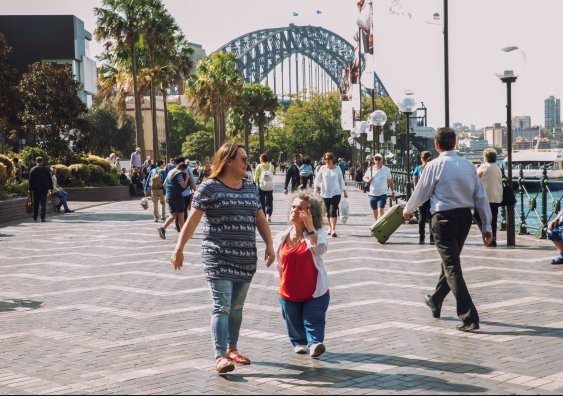Arts and mental health festival returns to tackle life’s biggest anxieties
The 2019 Big Anxiety Festival seeks to breakdown stigma and build empathy to battle mental health
The 2019 Big Anxiety Festival seeks to breakdown stigma and build empathy to battle mental health

From experiential virtual reality works to awkward conversations about topics like gender dysphoria, the Big Anxiety Festival returns this week to transform the ways people think about and communicate when it comes to mental health.
Hosted by UNSW Sydney and the Black Dog Institute, the Big Anxiety Festival is a biennial event combining art, science and technology to deliver the largest arts and mental health festival in the world. Leading national and international artists, technology experts, scientists and thinkers will present more than 60 events across Sydney from 27 September to 9 November.
“It is a different kind of festival. We are breaking new ground and occupying space between art and health,” said UNSW Art & Design Scientia Professor Jill Bennett, the Festival’s artistic director.
“Those things are usually quite separate. There are not many big art festivals in Australia, or anywhere else in the world, that bring art and health together despite the data showing that engaging in art does improve health. It is not something that we systematically harness in a big way.”
The 2019 festival, which coincides with Mental Health Month in October, focuses on empathy – the ability to understand and share the feelings of another. The main exhibition of the festival is the Empathy Clinic, which brings together renowned national and international artists investigating their own and others’ experiences of anxiety, mental health, stigma and oppressive circumstances. It includes newly commissioned immersive artworks presenting first-person and embodied perspectives of challenging lived experiences that are uniquely designed to challenge assumptions about what art does, and how perspective sharing really affects us.
Professor Bennett, an Australian Research Council Laureate Fellow leading the felt Experience & Empathy Lab (fEEL) at UNSW, said neuroscientific evidence shows that we more readily empathise with people who we perceive to be like us. However, unless we can meet people who are different from ourselves and be comfortable with that difference, we cannot truly empathise.
“We have tried to flip around the conventional approach to stigma, which is quite didactic and is about sharing information about why stigma is wrong. But the focus on empathy is really about cultivating the skills you need to avoid those stigmatizing behaviours,” Professor Bennett said.
“We want people to enhance their empathy skills by being more imaginative and more capable when it comes to sitting and listening and entering into the perceptual world of someone else, even though it may not be something you immediately want to do. We have played with this metaphor of a clinic where you come out better than you went in.”
The Empathy Clinic aims to use art to enrich communication tools, particularly through virtual reality and the concept of perception sharing. In one virtual reality exhibit, Being Debra, participants step into the world of Dr Debra Keenahan, an artist, academic and disability activist with dwarfism.
In Being Debra Dr Keehahan, who holds a PhD in Psychology on the subject of Dehumanization and is currently completing a second PhD in Visual Arts at UNSW, offers the audience a taste of the embodied experience of being a dwarf in contemporary Australian society. It captures interactions that have happened to Dr Keenahan throughout her life including flashbacks to Debra’s memories of school, dating, and engaging with authority figures, including doctors, as well as her routine daily encounters in a park.
“Because we are so physically different from other people, it can be very hard for others to understand our experience and our perspective,” said Dr Keenahan, referring to herself and her daughter, Sarah, who also has the condition achondroplasia dwarfism. “Consequently, that can all too often, unfortunately, lend itself to people dehumanising us – they objectify us, infantilise us and treat us like children or dolls. Virtual reality provides an opportunity in which to immerse people in the sorts of interactions and present them with the perspective that we experience better than any other medium.”

Dr Debra Keenahan will present Being Debra at the 2019 Big Anxiety Festival. The virtual reality project gives audiences a first-hand experience of what it is like to live with the condition achondroplasia dwarfism.
In addition to creating the clinic, a team of artists and psychologists from fEEL developed an app-based Course of Empathy, a practical tool to complement a participant’s visit to The Empathy Clinic. It is also available to anyone seeking to enhance empathy skills.
The festival will also feature the world premiere of two new virtual reality works exploring mental health and healing from Aboriginal perspectives, created by the acclaimed collective project Uti Kulintjaku (UK). Formed from the Ngangkari traditional healers and artists of the NPY Women’s Council, the UK addresses community issues of mental health from both Aboriginal and Western perspectives. Working with Big Anxiety and fEEL, the team have created two new virtual reality works, sharing their healing practices through creative visualisation, including Waumananyi: The Song on the Wind, an Anangu-led response to the experiences of constraint, entrapment and depression through the traditional story of The Man in the Log.
Both virtual reality projects are designed by UNSW Art & Design’s Volker Kuchelmeister, a senior research fellow in fEEL at the National Institute of Experimental Arts.
“The virtual reality experience asks ‘what is it really like to be physically and mentally trapped in a space that you can’t escape from?’ In this case you can see through holes in the log and you can see people you love and people in your community, but you can no longer connect with them. It became a profound metaphor for incarceration, separation, addiction and that sense of powerlessness that many people experience.”
The Big Anxiety Festival opens on 27 September and runs until 9 November 2019 at venues across Sydney.